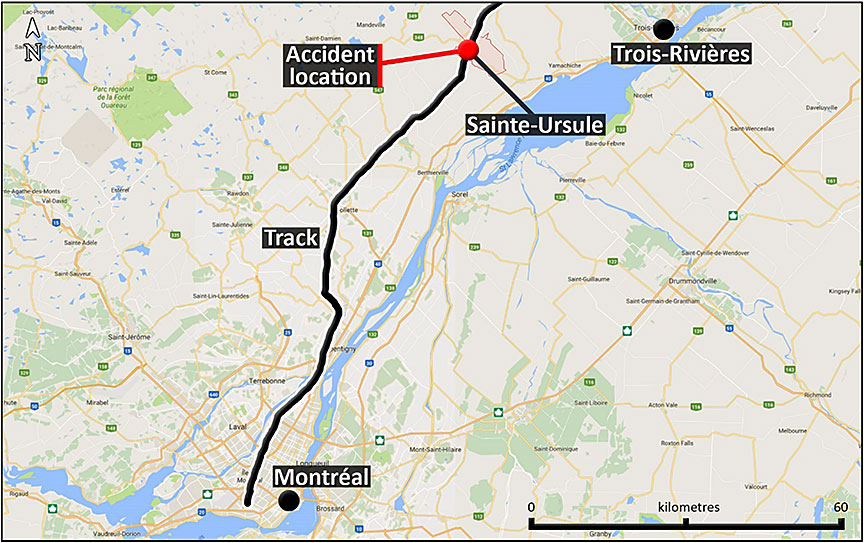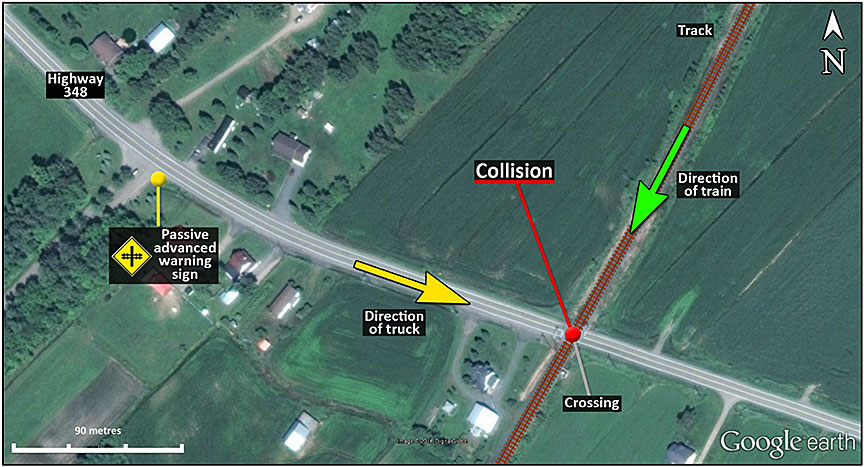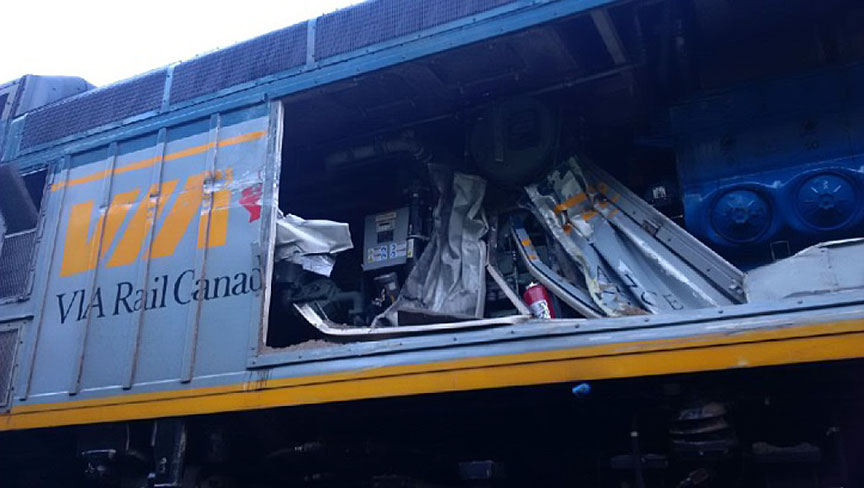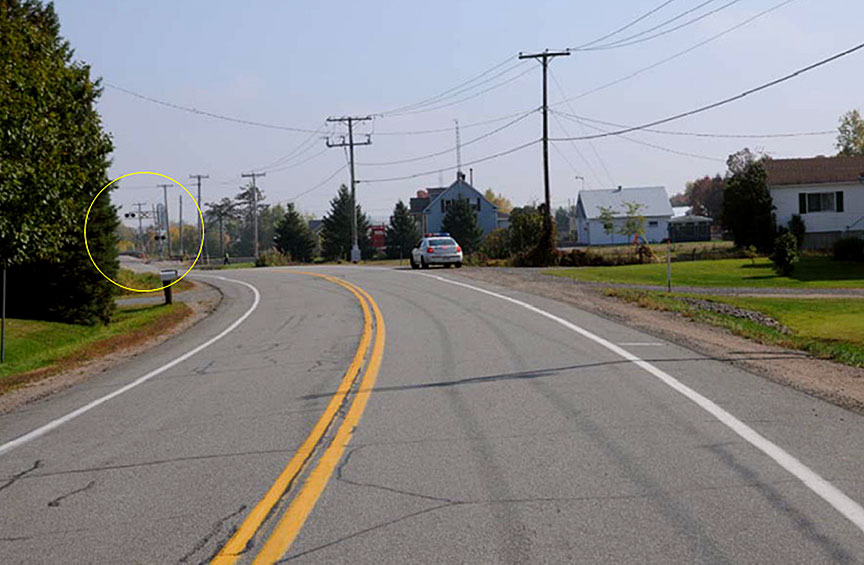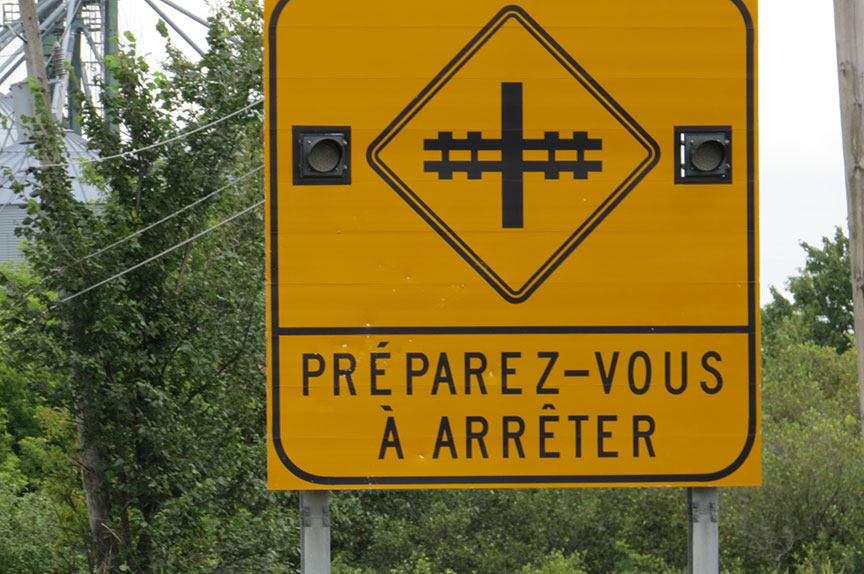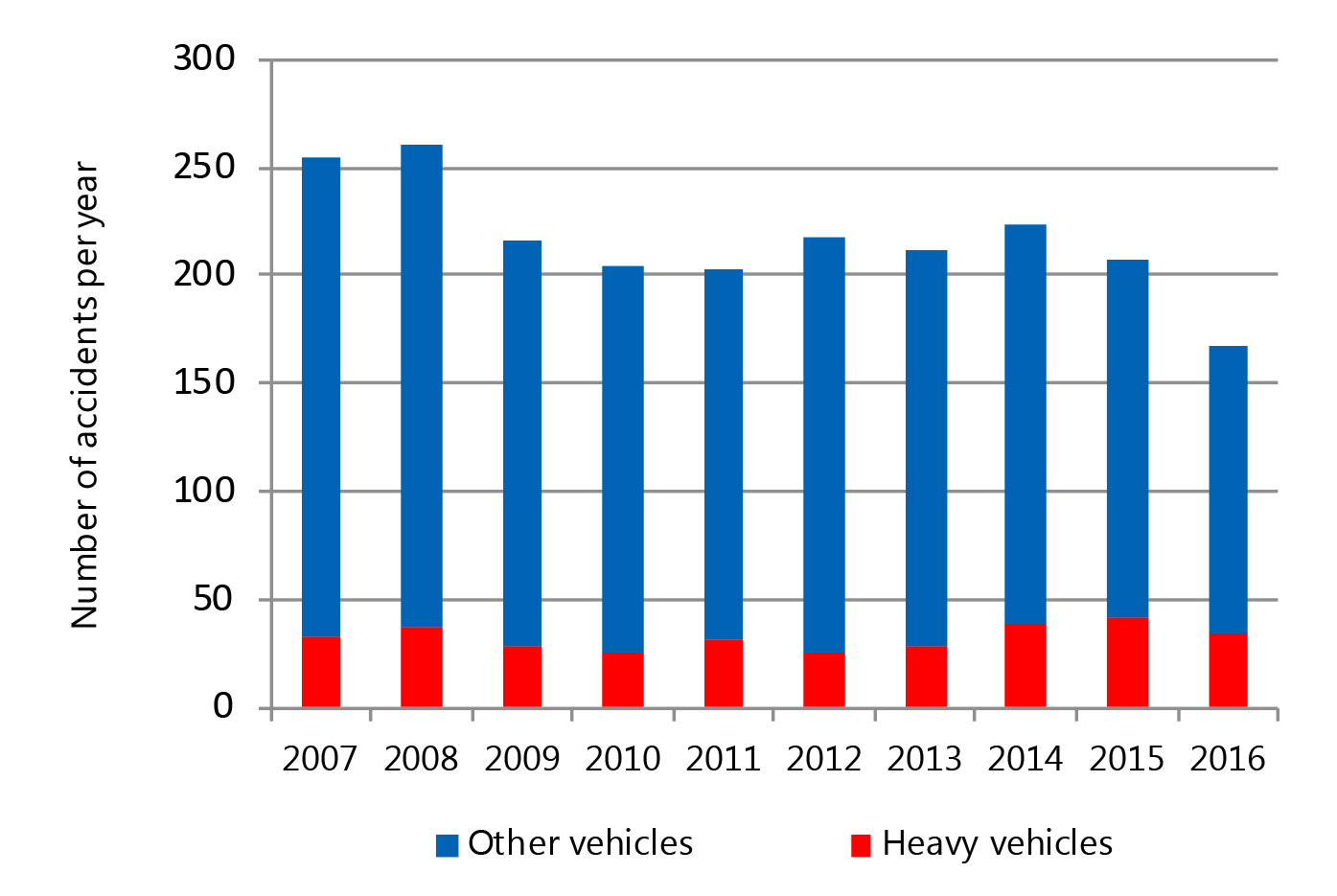Crossing collision
VIA Rail Canada Inc.
Passenger train No. 600
Mile 75.34, Canadian National Railway Company
Joliette Subdivision
Sainte-Ursule, Quebec
The Transportation Safety Board of Canada (TSB) investigated this occurrence for the purpose of advancing transportation safety. It is not the function of the Board to assign fault or determine civil or criminal liability. This report is not created for use in the context of legal, disciplinary or other proceedings. See Ownership and use of content. Masculine pronouns and position titles may be used to signify all genders to comply with the Canadian Transportation Accident Investigation and Safety Board Act (S.C. 1989, c. 3).
Summary
On 20 September 2016, at approximately 1605 Eastern Daylight Time, VIA Rail Canada Inc. passenger train No. 600 was travelling southward at 60 mph on the Canadian National Railway Company Joliette Subdivision. The train was struck by a tractor-trailer at the Highway 348 public crossing at Mile 75.34 in Sainte-Ursule, Quebec. The first coach derailed, and the rail cars as well as the locomotives were damaged. Approximately 1860 gallons of fuel was spilled. The track and the crossing warning system were also damaged, and the tractor-trailer was destroyed. The driver sustained serious injuries, and 2 passengers on the train sustained minor injuries.
Le présent rapport est également disponible en français.
Factual information
The accident
On 20 September 2016, at approximately 1440,Footnote 1 VIA Rail Canada Inc. (VIA) passenger train No. 600 left Hervey-Jonction, Quebec, bound for Montréal, Quebec, on Canadian National Railway Company (CN) tracks. The train was composed of 2 trains joined togetherFootnote 2 (in a "J" configuration). The train weighed approximately 500 tons and was 450 feet long.
The crew consisted of 1 operating locomotive engineer (OLE) and 1 in-charge locomotive engineer (ICLE). Both crew members were qualified for their respective positions and met fitness and rest standards.
At approximately 1605, the train was travelling southward at 60 mph while approaching the Highway 348 crossing, at Mile 75.34 of CN's Joliette Subdivision (Figure 1). When the train was approximately 2000 feet from the crossing, the crossing warning system was activated. The bell, flashing lights, and gates worked as intended. The OLE sounded the horn, as per existing regulations. The locomotive headlights were turned on bright, the ditch lights were illuminated, and the bell was activated.
After the warning system activated, an automobile stopped approximately 75 feet from the crossing. At that time, a tractor-trailer loaded with sand was coming out of the curve west of the crossing and was approaching the crossing.Footnote 3 When the tractor-trailer was approximately 200 feet from the crossing, it deviated into the left lane to go around the stopped car. The tractor-trailer struck the warning system's gate and entered the crossing as the train was arriving. The tractor-trailer struck the right side of the lead locomotive. The OLE applied the emergency brakes, and the train came to a stop approximately 2500 feet past the crossing.
The tractor-trailer was pushed south, struck the south cantilevered post of the crossing warning system and a utilities post, and came to a stop in the ditch. The trailer unhooked from the tractor and tipped sideways. The driver sustained serious injuries.
The first coach of the train derailed but remained upright. The right side of the other cars and of both locomotives was damaged. Fuel from the tanks of both locomotives spilled along the track.
After the train came to a stop, the 2 on-board service personnel looked after the passengers. Two passengers in the first coach sustained minor injuries. First responders arrived on scene at approximately 1630 and took care of the injured persons. Some 90 minutes later, all passengers were transported by bus to Montréal's Central Station.
At the time of the accident, the temperature was 25 °C with clear skies.
Site examination
At the railway crossing, at Mile 75.34 of the Joliette Subdivision, the speed limit on Highway 348 is 90 km/h. At the crossing, the road is perpendicular to the railway track. Drivers coming from the west must negotiate a left-hand curve that ends approximately 500 feet from the crossing. From the beginning of the curve up to the crossing, the lane separation lines painted on the roadway were in good condition and indicated a no-passing zone. In the curve, approximately 730 feet from the crossing, there was a passive advanced crossing warning road sign (Figure 2). No fresh braking marks were observed on the road surface between the advanced sign and the crossing.
The tractor-trailer was destroyed (Figure 3). The tractor cabin, the engine and the axles were ripped from the frame and thrown into the ditch along the railway track. The fuel tanks ruptured and spilled approximately 60 gallons of fuel. The trailer, which detached from the tractor, came to rest on its side, parallel to the track and blocking the road. The tarp that covered the trailer was ripped off and the load of sand spilled onto the track. The trailer frame was twisted and its upper lateral stiffeners were torn.
On the south side of the crossing, the rail spikes were lifted and the rail was slightly deformed over approximately 40 feet. From that point on, there were grooves running southward along the track. The ties were grooved and some of them had split.
The lead locomotive (VIA 6443) came to a stop approximately 2500 feet from the crossing. It sustained damage mostly to its brake connections and cylinders, axles, suspension and battery box. Its fuel tank was punctured.
Both trucks of the first coach derailed; the rear truck was damaged and the right side of the car body was bent in the middle. The front right corner of the first baggage car was deformed and its vertical support was dented (Figure 4). The engine access panels on the second locomotive (VIA 6413) were torn off (Figure 5). The fuel tank of the second locomotive was ruptured, and braking system and suspension components were damaged (Figure 6). The second baggage car and the second coach were slightly damaged. Approximately 1800 gallons of fuel from the locomotives spilled along the track.
Subdivision information
The Joliette Subdivision is a single main track that runs north-south from the Garneau Yard, Mile 40.1, to Pointe-aux-Trembles, Quebec, Mile 127.8. Between Mile 41.8 and Mile 123.8, train movements are governed by the occupancy control system rules as authorized by the Canadian Rail Operating Rules and supervised by a CN rail traffic controller located in Montréal.
In the accident area, rail traffic consists of approximately 5 freight trains and 1 passenger train per day. The authorized speed limit is 50 mph for freight trains and 60 mph for passenger trains.
Track information
The main track consisted of 115-pound continuous welded rail, laid on double-shouldered tie plates, fastened with 2 spikes per tie and anchored every second tie. The ballast consisted of crushed rock. Inspections had been performed as required by the Rules Respecting Track Safety. The last visual track inspection, performed on 19 September 2016, had found no defects.
Highway 348 crossing
The crossing is located at the intersection between Highway 348, locally known as "Rang des Chutes," and the railway tracks at Mile 75.34 of the Joliette Subdivision. Approximately 1450 vehicles go through this crossing every day. The roadbed was approximately 35 feet wide and its surface was asphalt.
The crossing warning system at the Highway 348 crossing had been updatedFootnote 4 in 2005 and 2006. It consisted of cantilevered light units, light-emitting diode (LED) flashing lights, gates and a bell. CN had tested the warning system on 16 September 2016 and no defect was found. Because of the curve west of the crossing, the lenses of the front cantilevered light units facing west were aligned so as to be visible from a distance of 730 feet.
According to Transport Canada's (TC) Grade Crossing Inventory,Footnote 5 in 2016, the occurrence crossing was ranked 1944th. This list provides a ranking of risk using the GradeX tool, an internal web-based analysis tool that compares crossings against each other based on the following factors:
- railway accident data contained in the TSB database;
- road traffic volume;
- maximum train and vehicle speed;
- number of railway tracks and road lanes;
- urban or rural environment; and
- warning systems in place at the crossing (gates, bells, lights, etc.).
Accident data
According to the TSB railway occurrence database, there was only 1 other accident involving a train and a road vehicle at this crossing during the 20-year period from September 1996 to September 2016 (10 years before the crossing upgrading work and 10 years after). However, the TSB database only contains occurrences involving a train.
According to data from the Société de l'assurance automobile du Québec (SAAQ), for the same period, there were 6 other accidents in the vicinity of this crossing. Those 6 accidents revealed the following:
- Five accidents involved heavy vehicles.
- On 2 separate occasions, while a train was at the crossing, heavy vehicles travelling east were unable to stop in time. The drivers had to drive their vehicle into the ditch to avoid colliding with the train.
- On 3 occasions, vehicles travelling east collided with a vehicle at this crossing.
Since the completion of the crossing upgrade in 2006, which improved the visibility of the warning system, this occurrence is the first to have occurred in the vicinity of the crossing.
Recorded information
Post-accident inspection of the flashing lights, bell, and gates found no pre-existing anomalies. The crossing event recorder indicates that when the train activated the circuit as it approached the crossing, the flashing lights, bell, and gates activated as per the regulations. The flashing lights and bell activated for 24 seconds before the train arrived. The gates had been fully horizontal for 11 seconds when the warning system detected a faultFootnote 6 with a gate.
Tractor-trailer
The tractor-trailer consisted of a tractor and a dump body trailer loaded with sand. Their combined gross weight was 58 300 kg (128 500 pounds). The tractor was a 2001 Western Star model, and the trailer was a 2009 Stargate. Both were equipped with anti-lock braking systems (ABS). They were registered in the province of Quebec and had passed their last annual safety inspections.Footnote 7 The tractor and the trailer were examined by road vehicle inspectors after the occurrence. No pre-existing mechanical defects were found.
No data from the tractor were available for the investigation, such as from an electronic data recorder, engine control unit, portable or installed GPS or mobile device. Examination of the tractor dashboard and its instruments revealed that the needle of the tachometer was stuck at 1200 rpm and the needle of the speedometer was stuck at 22 mph (35 km/h).Footnote 8
Pre-trip inspection
On the morning of the accident, the driver had performed a pre-trip inspection before departure as required by the SAAQ. The pre-trip inspection is a visual and auditory examination of the accessible components of the vehicle, including the tires and the braking system. No anomalies were noted.
Driver
The driver of the tractor-trailer met fitness and rest standards and was qualified for his position. The driver had some 12 years of experience driving heavy vehicles. The driver's work shift had started at approximately 0500 and he had worked 13 hours during the last 36 hours. During the month preceding the accident, the driver had done 2 or 3 trips per day. The driver would load the tractor-trailer at a sandpit some 10 km from the crossing and would drop off the load at a concrete plant on the South Shore of Montréal, approximately 100 km from the sandpit. On average, each return trip would take approximately 4 hours. The accident occurred during the driver's third trip of the day.
The driver had been transporting sand from this sandpit for several years. The driver was very familiar with the area, always drove along the same route and did not recall ever having encountered a train at this crossing.
Drivers approaching crossings
Because drivers do not generally encounter trains at crossings, each time they go through a crossing reinforces their perception that a train is unlikely to appear. A literature review by Yeh and MulterFootnote 9 determined that drivers who are familiar with a crossing are less likely to look for a train at the crossing or to reduce their speed on their approach to the crossing than drivers who are unfamiliar with the crossing.
Driving in a curve
Driving in a curve increases driver mental workload as compared with driving on a straight road,Footnote 10 and affects where drivers will focus their attention ahead of them.
On a straight road, drivers maintain lane position and direction by looking straight ahead and by continuously processing the information received from their peripheral vision to guide their actions at the wheel. In a curve, the position of the vehicle in the lane and the position in which it will be are visually distinct zones, so that drivers must repeatedly divide their attention between those 2 positions, which doubles their visual demands.Footnote 11
Studies that measure drivers' eye movements in a curve have found that, when driving during the day with no vehicles in front of them, drivers tend to focus their visual attention in the direction in which the vehicle will be turning.Footnote 12
Section 6, "Driving Techniques," of the Driving a Heavy Vehicle bookletFootnote 13 highlights the importance of heavy vehicle drivers staying alert and looking far ahead. "Looking far ahead" means looking at the distance to be covered in the next 12 to 15 seconds. However, when tractor-trailer drivers are negotiating a curve, they must direct their vehicle toward the outside of the curve and drive along the edge of their lane with their tractor to prevent the trailer from going into the adjacent lane. Drivers must maintain their vehicle in this position until they are coming out of the curve, then bring it back to the middle of the lane. During this manoeuvre, drivers must focus their visual attention far ahead toward the obstacles blocking their view of the road and look toward the outside of the roadway.
Stopping sight distances
The stopping sight distance (SSD) is the total distance travelled by a vehicle between the moment the driver perceives an obstacle and the moment the vehicle comes to a complete stop. This distance represents the distance travelled during the perception and reaction time of the driver, plus the braking distance. It varies depending on the speed of the vehicle and must be modified depending on the road gradient.
The braking distance used for the SSD is calculated conservatively. It is based on a deceleration rate that is less than full-on braking. Calculating the SSD this way means that vehicles with less powerful braking systems will be able to stop in time on a damp roadway.
The SSD for a truck on a road where the speed limit is 90 km/h is 265 m (869 feet). Given that Highway 348 has a gradient of approximately 3% over a distance of approximately one quarter of a mile (1320 feet) before the crossing, the SSD for a truck travelling at 90 km/h increases to 277 m (909 feet) to take this into consideration.Footnote 14Footnote 15
Vehicles coming from the west on Highway 348 must negotiate a left-hand curve before they reach the crossing. The trees along the road interfere with the visibility of the crossing warning system, which only becomes partially visible approximately 800 feet before the crossing (Figure 7).
The warning system becomes completely visible at a distance of approximately 730 feet from the crossing (Figure 8). From that point on, the curve continues over a distance of approximately 230 feet, at which point the road becomes straight for 500 feet up to the crossing.
According to the Transportation Association of Canada, the average braking distance for a tractor-trailer, on an asphalted road, travelling at a speed of 90 km/h and taking into consideration the 3% descending grade of the road toward the crossing, would be approximately 535 feet. To come to a stop within that distance, the driver must apply full brakes and the roadway must be dry and in good condition.
Reaction time
Reaction time encompasses detection, identification, decision, and initiation of an action. Several studies have been conducted for road vehicle drivers, and the results give some indication of driver performance when visual stimuli require a reaction, including braking. In calculating sight distances and stopping distances for road vehicles, a minimum reaction time of 2.5 seconds is recommended as it relates to the placement of road signs and public railway crossings.Footnote 16 It is recognized that the complexity of a situation and unexpected stimuli entail significantly longer reaction times.Footnote 17
Crossing warning systems
A number of crossing warning systems are available to alert drivers to the presence of impending dangers. For example, advanced warning road signs with flashing lights, rumble strips on the road, or improved delineation with retroreflective signs can be appropriate means of achieving this.
Research on advanced warning signsFootnote 18 indicates that, in locations where yellow flashing lights were added to a slightly larger advanced warning sign and where the lights were activated by a train, drivers were much more likely to recognize the signals and slow down. These signs alert drivers to the presence of a train at the crossing approximately one quarter of a mile ahead of the crossing. There is such a sign at the Highway 347 crossing in Saint-Norbert, Quebec, at Mile 90.61 of the Joliette Subdivision (Figure 9).
Grade Crossings Regulations
On 27 November 2014, the new Grade Crossings Regulations came into force. The Regulations include a 7-year transition period (up to 2021) for existing grade crossings that must be modified to comply with the new regulations.
The previous regulationsFootnote 19 did not specify any standard regarding SSD nor any condition where a "Prepare to Stop at Railway Crossing" sign had to be installed. However, the new Grade Crossings Regulations do require such a sign when the visibility of the crossing warning system is less than the SSD.
Subsections 51(1) and 51(2) of the Grade Crossings Regulations specify the following:
- A Prepare to Stop at Railway Crossing sign must be installed if
- at least one set of front light units on the warning system is not clearly visible within the stopping sight distance of at least one of the lanes of a road approach; or
- the weather conditions at the grade crossing repeatedly obscure the visibility of the warning system.
- The Prepare to Stop at Railway Crossing sign must meet the standards set out in article 18 of the Grade Crossings Standards.
Section 18 of the Grade Crossings Standards, "Prepare to Stop at Railway Crossing Sign," states the following:
- 18.1 The Prepare to Stop at Railway Crossing sign must be as shown in A3.6.6 of the Manual of Uniform Traffic Control Devices for Canada (cited in Part A), must meet the applicable specification in article A1.6 of that Manual, and must operate:
- in advance of the activation of the light units of the warning system and:
- during the time of the operation of the light units of the warning system.
- 18.2 The advance activation time must be the greater of the time it takes a vehicle travelling at the road crossing design speed to pass a deactivated Prepare to Stop at Railway Crossing sign and the vehicle to:
- clear the crossing before the arrival of railway equipment at the crossing surface where there is a warning system without gates; or
- clear the grade crossing before the gate arms start to descend where there is a warning system with gates.
- 18.3 Where a Prepare to Stop at Railway Crossing sign is installed, 4 hours continuous battery back-up power must be provided for the Prepare to Stop at Railway Crossing signs.
Grade crossing accident statistics
According to the TC database, there are approximately 20 000 public grade crossings in Canada. Of these, 6800 are equipped with warning systems, approximately 2600 of which have gates.
A search in the TSB database determined that, for the 10-year period between 2007 and 2016, there have been 1842 crossing accidents, 325 involved heavy vehicles. The yearly average has remained relatively stable between 2009 and 2014. The number of accidents has decreased since 2014 (Figure 10).
Analysis
All the components of the crossing warning system were in working order and the system worked as intended for approximately 24 seconds before the train arrived. The train was operated as required by existing regulations. The tractor-trailer was in good condition, and a post-occurrence inspection found no anomalies. The tractor-trailer driver met fitness and rest standards and was qualified for the position. Therefore, the analysis will focus on the driving of the tractor-trailer, the braking distance, the visibility of the crossing warning system, and the existing regulations.
The accident
Given the lack of recorded data, it was not possible to determine with certainty the speed at which the tractor-trailer approached the crossing, the distance from the crossing at which the driver started to brake or the speed at which the tractor-trailer struck the train. However, post-occurrence examination of the vehicle's speedometer revealed that the speed at impact was 35 km/h, indicating that the driver tried to stop the vehicle before it reached the crossing. When the driver noticed that the warning system was activated and that an automobile was already stopped at the crossing, the driver started braking to try to stop the truck. When the driver realized that he would not be able to stop before the car that was stopped at the crossing, he deviated into the left lane and avoided pushing the car toward the train. The tractor-trailer was unable to stop before the crossing and struck the warning system gate, then struck the train. The tractor-trailer was pushed into the ditch, and the first coach of the train derailed.
Driving a vehicle
Given the distance at which the warning system became completely visible, the driver should have had enough time to react and stop the vehicle before the crossing. In addition, the driver was very familiar with the road, having made 3 trips per day along that route over the last several weeks. The driver was not expecting to encounter a train at this crossing, and there were no road conditions to make him expect to have to stop after the curve. Therefore, the driver's level of alertness regarding the crossing warning system was lessened.
Drivers of heavy vehicles must be alert and look far ahead in order to react to road conditions. However, in this occurrence, while negotiating the curve, the driver's visual attention was not focused far ahead where the warning system was located. According to good driving practices, when tractor-trailer drivers are negotiating a curve, they must direct their vehicle toward the outside of the curve and drive along the edge of their lane with their tractor to prevent the trailer from going into the adjacent lane. Drivers must keep the vehicle in this position until they are coming out of the curve and then bring it back to the middle of the lane. Their visual attention becomes divided between the obstacles blocking their view of the road and the outside of the roadway. Therefore, while the tractor-trailer driver was negotiating the curve, his visual attention was probably focused more on the outside of the curve rather than far ahead. Therefore, the driver did not immediately notice that the warning system was activated.
According to the Transportation Association of Canada's Geometric Design Guide for Canadian Roads, the average braking distance for a truck equipped with an anti-lock braking system (ABS) travelling at 90 km/h is approximately 535 feet.Footnote 20 At the point where the driver had to bring the tractor-trailer back to the middle of the lane and shift his attention forward, the vehicle was coming out of the curve and must therefore have been approximately 500 feet from the crossing. Given that this was less than the average braking distance, the tractor-trailer was too close to the crossing to be able to stop in time. As a result, the investigation concluded that the tractor-trailer driver realized that the warning system was activated when the vehicle came out of the curve. At that distance, he was no longer able to stop the vehicle before it reached the crossing.
Sight distance
Drivers' experience, skills, and training vary significantly. Sight distances must therefore be sufficient to enable all drivers, regardless of their training, to safely come to a stop or avoid obstacles on the road. Furthermore, different braking systems must be taken into consideration. Recent systems such as ABS shorten braking distances; however, many vehicles on the road are still not equipped with such systems.
In this occurrence, the curve west of the crossing obstructed the visibility of the warning system, which only became completely visible at a distance of 730 feet. From that point, a tractor-trailer equipped with ABS and approaching at 90 km/h could theoretically stop before the crossing, whereas a similar vehicle with no ABS travelling on a damp roadway would require 909 feet (distance equal to the stopping sight distance [SSD]). Therefore, the visibility of the crossing warning system must enable the drivers of approaching vehicles to see the warning devices at a distance at least equal to the SSD. If the warning system cannot be perceived at a distance at least equal to the SSD, motor vehicle drivers may not be able to stop before the crossing, thereby increasing the risk of accidents.
Existing regulations
The previous regulations did not specify any standard regarding SSD nor any condition where a "Prepare to Stop at Railway Crossing" sign had to be installed. However, Transport Canada's (TC's) new Grade Crossings Regulations requires that, by 2021, an active "Prepare to Stop" sign be installed when the crossing lights are not clearly visible within the limits of the SSD. The SSD for vehicles coming from the west on Highway 348 is 909 feet, whereas the crossing warning system is visible from 730 feet. Given that the visibility of the lights of the grade crossing warning system is less than the SSD, an active "Prepare to Stop at Railway Crossing" sign connected to the crossing warning system will be required at that location by 2021 in accordance with TC's new Grade Crossings Regulations.
Transport Canada's ranking of grade crossings
TC uses the GradeX tool to compare and rank crossings against each other based on their level of risk. This tool uses several criteria to assess risks, including accident history at a given crossing based on the TSB database. However, TSB data only pertain to occurrences directly involving railway equipment; accidents that occurred in the vicinity of the crossing are not recorded. For the occurrence crossing, there were only 2 accidents in the TSB database, whereas there were 6 other accidents in the immediate area around the crossing. Although those 6 accidents only involved road vehicles, they occurred at the crossing and should therefore be taken into consideration when assessing the safety of the crossing. The risk assessment of a crossing is based only on accidents recorded in the railway occurrence database and does not take into consideration other accidents that may have involved driver behaviour in the vicinity of the crossings.
Findings
Findings as to causes and contributing factors
- The tractor-trailer was unable to stop before the crossing and struck the warning system gate, then struck VIA Rail Canada Inc. passenger train No. 600.
- The driver was not expecting to encounter a train at the crossing. Therefore, the driver's level of alertness regarding the crossing warning system was lessened.
- While the tractor-trailer driver was negotiating the curve, his visual attention was probably focused more on the outside of the curve rather than far ahead. Therefore, the driver did not immediately notice that the warning system was activated.
- The tractor-trailer driver realized that the warning system was activated when he came out of the curve. At that distance, he was no longer able to stop the vehicle before it reached the crossing.
Findings as to risks
- If the warning system cannot be perceived at a distance at least equal to the stopping sight distance, motor vehicle drivers may not be able to stop before the crossing, thereby increasing the risk of accidents.
Other findings
- When the driver realized that he would not be able to stop before the car that was stopped at the crossing, he deviated into the left lane and avoided pushing the car toward the train.
- Given that the visibility of the lights of the grade crossing warning system is less than the stopping sight distance, an active "Prepare to Stop at Railway Crossing" sign connected to the crossing warning system will be required at that location by 2021 in accordance with Transport Canada's new Grade Crossings Regulations.
- The risk assessment of a crossing is based only on accidents recorded in the railway occurrence database and does not take into consideration other accidents that may have involved driver behaviour in the vicinity of the crossings.
Safety action
Safety action taken
Transportation Safety Board of Canada
On 18 July 2017, the Transportation Safety Board of Canada (TSB) issued Rail Safety Advisory (RSA) 10/17 to Transport Canada (TC). The RSA indicated that, when the risk assessment of a crossing is based only on accidents entered in the railway occurrence database and does not take into account other accidents that occurred in the vicinity of the crossing, the real risks to the public may be underestimated. As a result, resources may not be allocated to the most appropriate locations to reduce risks to the public. Therefore, the TSB suggested that TC consider including accidents that occurred in the vicinity of railway crossings to assess their impact on safety.
On 28 September 2017, TC acknowledged that the data on rail occurrences is a very important source for road authorities, railways, and TC to improve crossing safety. However, TC did not indicate that it would take any action on this issue.
Ministère des Transports, de la Mobilité durable et de l'Électrification des transports
The Ministère des Transports, de la Mobilité durable et de l'Électrification des transports evaluated the Highway 348 crossing in Sainte-Ursule and will install an active advance warning sign on the approach to this crossing in 2018.
This report concludes the Transportation Safety Board of Canada's investigation into this occurrence. The Board authorized the release of this report on 06 December 2017. It was officially released on 11 December 2017.
